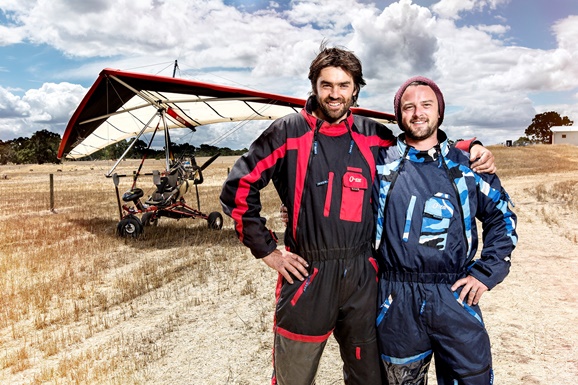Charlie Hill-Smith’s feature documentary Motorkite Dreaming, screening at Dungog Festival this weekend, isn’t your typical adventure film.
Motorkite Dreaming follows two friends and their fiancés on a 4,000 kilometre journey across outback Australia – from Adelaide to Broome – on second-hand microlight aircraft, essentially ‘hang-gliders with lawn mower engines’.
The pilots – Aidan Glasby and Daryl Clarke – are amateurs, so there were “just the right number of crashes” along the way, director Hill-Smith told IF.
“If there is a perfect type or number of plane crashes, I think we had it. No one got hurt seriously and no one died,” he said. “These guys only got their licences a week before we left. So inexperienced isn’t really summing it up.”
Motorkite Dreaming had a limited cinema tour back in August and continues to travel, doing roadshow screenings in local communities. A 5×26 TV series version will also broadcast later this year on NITV and SBS Viceland, and through Red Bull TV’s global internet channel.
However, adventure is only one part of this film’s story – what Hill-Smith has described a “Trojan Horse” narrative.
The adventurers’ journey takes them across 20 Aboriginal language nations, where they learn from the different communities about their culture.
Along the way they are also guided by Carroll Karpany, founding member of seminal 80’s Aboriginal rock band Us Mob, and his audio mixer, Bart Sansbury.
“When [Aidan] called me eight years ago and said he wanted to do this, I knew exactly what he was on about. He wanted to make a film that would be fun, adventurous and really connect with people; with a middle Australian’s sense of adventure. But underlying all the chutzpah, froth and bubble was a story about Aboriginal Australia,” said Hill-Smith.
“The Trojan Horse narrative thing is that it look walks, flies and quacks like an adventure duck, but it’s actually a cross-cultural film.”
The filmmakers strived to ensure that they made a film that respected Indigenous culture, and that included Aboriginal leaders and elders – just part of the reason why Carpany and Sansbury were asked to get involved.
A year before the shoot, Carpany and Sansbury drove Hill-Smith, producer John Cherry and the two pilots out into the communities they would visit in the film. There, they met the traditional owners and elders and asked for their permission to make the film.
“We explained what [the film] was, what we were trying to achieve with it. That it was a cross-cultural film; that we were trying to hold up Aboriginal culture and we wanted to celebrate Aboriginal culture in a way that has not been done nearly enough,” said Hill-Smith.
“This is what Australian filmmakers, if they’re going to work with Aboriginal Australians, need to do. You need to give them ownership. You need to involve the communities, the leaders, elders and stakeholders, right from the start.”
Hill-Smith wants Motorkite Dreaming to connect with an middle Australian, city-dwelling audience – with hopes that they’re thrilled by the adventure, but also walk away inspired by a taste of Indigenous culture.
“A lot of non-Aboriginal people have very few Aboriginal experiences. A lot of us aren’t taught much about Aboriginal culture. And most importantly, we live in what I regard as an ahistorical culture [in] Australia, where we don’t know our history,” he said.
Given the aim of the film, it’s somewhat of an irony that the filmmakers had to go to Austria – to Red Bull – before they could get financing to post-produce the film.
Despite some initial development funding from Film Victoria, Hill-Smith and his team, including producer John Cherry, financed the film themselves after broadcaster interest fell over.
“It’s a difficult time in Australia. The digital disruption means that a lot of the traditional broadcasters of documentary are in flux. They don’t really know where the future is,” said Hill-Smith.
After the shoot, the filmmakers cut some clips and a teaser, but again, despite praise, no money was forthcoming. Hill-Smith and Cherry feared the film was dead in the water until an email sent off to Red Bull bore fruit, and Red Bull invested in producing the five part series for their streaming platform.
Screen Australia then came on board to help bankroll the feature.
“Screen Australia were brilliant, they came in – and then we cut both [the series and the feature] at the same time. Which was a nightmare (laughs),” said Hill-Smith.
The film was shot back in 2013 over 10 weeks. Multiple Go-Pros were strapped to the microlights to capture footage from the air, as well as digital cameras on the ground – around 1,000 hours of footage was captured.
The shoot was tough for the crew, said Hill-Smith – shooting from dawn to dusk, often in trying weather conditions.
“It was full on, it was really demanding of all them. But it was a life changing experience for all of us. We all just learned so much about Australia. White, black, Aboriginal and non-Aboriginal,” said Hill-Smith.
Motorkite Dreaming screens this Saturday October 29 at Dungog Festival. Producer John Cherry and EP Marcus Gillezeau will be in Q&A following the screening.
http://www.dungogfestival.com.au/
NITV: Premiere December 5th 7.30pm x 5 Mondays
Red Bull TV: Premiere December 26th
SBS Viceland: Broadcasting early 2017



